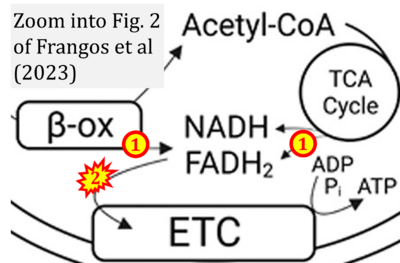Frangos 2023 J Biol Chem
| Frangos SM, DesOrmeaux GJ, Holloway GP (2023) Acidosis attenuates CPT-I supported bioenergetics as a potential mechanism limiting lipid oxidation. https://doi.org/10.1016/j.jbc.2023.105079 |
» J Biol Chem 299:105079. PMID: 37482278 Open Access
Frangos Sara M, DesOrmeaux Genevieve J, Holloway Graham P (2023) J Biol Chem
Abstract: Fuel interactions in contracting muscle represent a complex interplay between enzymes regulating carbohydrate and fatty acid catabolism, converging in the mitochondrial matrix. While increasing exercise intensity promotes carbohydrate use at the expense of fatty acid oxidation, the mechanisms underlying this effect remain poorly elucidated. As a potential explanation, we investigated whether exercise-induced reductions in intramuscular pH (acidosis) attenuate carnitine palmitoyltransferase-I (CPT-I) supported bioenergetics, the rate-limiting step for fatty acid oxidation within mitochondria. Specifically, we assessed the effect of a physiologically relevant reduction in pH (pH 7.2 vs 6.8) on single and mixed substrate respiratory responses in murine skeletal muscle isolated mitochondria and permeabilized fibers. While pH did not influence OXPHOS stoichiometry (ADP/O ratios), coupling efficiency, oxygen affinity or ADP respiratory responses, acidosis impaired lipid bioenergetics by attenuating respiration with L-carnitine and palmitoyl-CoA, while enhancing the inhibitory effect of malonyl-CoA on CPT-I. These acidotic effects were largely retained following a single bout of intense exercise. At rest, pyruvate and succinate supported respiration were also impaired by acidosis. However, providing more pyruvate and ADP at pH 6.8 to model increases in glycolytic flux and ATP turnover with intense exercise, overcame the acidotic attenuation of carbohydrate-linked OXPHOS. Importantly, this situation is fundamentally different from lipids where CPT-I substrate sensitivity and availability is impaired at higher power outputs suggesting lipid metabolism may be more susceptible to the effects of acidosis, possibly contributing to fuel shifts with increasing exercise intensity. • Keywords: CPT-I, Mitochondrial bioenergetics, Exercise, Fuel metabolism, Lipid metabolism, pH, Skeletal muscle • Bioblast editor: Plangger M • O2k-Network Lab: CA Guelph Holloway GP
Correction: FADH2 and Complex II
- FADH2 is shown as the substrate feeding electrons into Complex II (CII). This is wrong and requires correction - for details see Gnaiger (2024).
- Gnaiger E (2024) Complex II ambiguities ― FADH2 in the electron transfer system. J Biol Chem 300:105470. https://doi.org/10.1016/j.jbc.2023.105470 - »Bioblast link«
Labels: MiParea: Respiration, Exercise physiology;nutrition;life style
Organism: Mouse
Tissue;cell: Skeletal muscle
Preparation: Permeabilized tissue, Isolated mitochondria
Enzyme: Complex II;succinate dehydrogenase
Regulation: Fatty acid
Coupling state: LEAK, OXPHOS
Pathway: F, N, S, NS
HRR: Oxygraph-2k
2023-07


